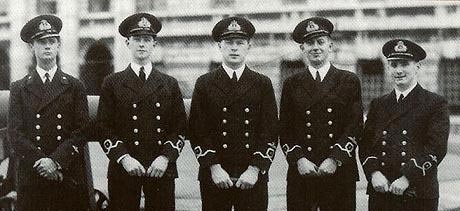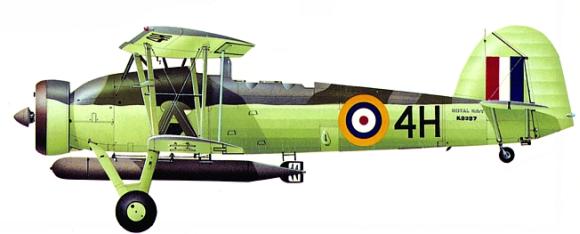
(From left) Eric Margetts, Bobby Lawson, John Moffat, Buster May and Glen Evans
We recently posted about the death of John “Jock” Moffatt, at 97, the Scottish pilot credited with disabling the German battleship Bismarck with a torpedo fired from his Fairey Swordfish biplane in May 1941. In the post, we included a photo of the pilots in the Swordfish squadron that attacked the ship.
Three blog readers, Seymour Hamilton, Captain D. Peter Boucher, and Philip Brankin, commented on one important detail that I missed entirely. In the photo, the pilots of the Swordfish squadron all wore the uniform of the Royal Naval Volunteer Reserve, a corps of civilian volunteers who served alongside Royal Navy and Royal Navy Reserve personnel. The wavy stripes on RNVR officers’ sleeves differentiated them from RN/RNR officers, and gave the group the nickname, the “Wavy Navy.”
What is so remarkable is that volunteer pilots flying obsolete biplanes succeeded in crippling the mightiest battleship in the German Kriegsmarine, after it had defeated the best that the Royal Navy could put against her.
In the Battle of Denmark Strait on May 24, 1941, the German battleship Bismarck sank the British battle cruiser HMS Hood in six minutes. Then, after a chase of several days pursued by a large British flotilla, the Bismarck was a about to escape. On the stormy evening of May 26, in heavy seas and only an hour’s worth of daylight left to stop the German ship, a squadron of Fairey Swordfish biplanes was launched from the carrier HMS Ark Royal. They were the last chance to stop the Bismarck, which would likely outrun her pursuers in the dark and in the morning would be under an umbrella of protective air cover.
The “Wavy Navy” pilots were flying lumbering biplanes which were considered obsolete by many when they first came off the assembly line in 1936. They had a metal frame but were covered in a skin of canvas. They had open cockpits, fixed wheels, were terribly slow and carried two machine guns which one pilot described as “one stage above the bow and arrow.” Early on, they earned the nickname “stringbag,” because like a shopper’s stringbag, they could carry almost anything. On May 24, the stringbags each carried a torpedo.
 Despite their shortcomings, as bi-planes, the Swordfish “stringbags” could take off in a very short space, which made them perfect for the small flight decks of the aircraft carriers of the day. They were also remarkably rugged, able to survive carrier landings and enemy bullets which passed cleanly through their canvas skins.
Despite their shortcomings, as bi-planes, the Swordfish “stringbags” could take off in a very short space, which made them perfect for the small flight decks of the aircraft carriers of the day. They were also remarkably rugged, able to survive carrier landings and enemy bullets which passed cleanly through their canvas skins.
Moffatt’s squadron of 15 stringbags attacked the Bismarck at almost wave top level despite heavy anti-aircraft fire. All planes returned to the Ark Royal and only one pilot and one gunner were wounded.
In 1958, the Royal Naval Volunteer Reserve, the Wavy Navy, was merged into the Royal Naval Reserve.
Despite being considered obsolete, the stringbag, the Fairey Swordfish, remained in service through the end of the war and sank more tonnage than any other Allied plane during the World War II.
